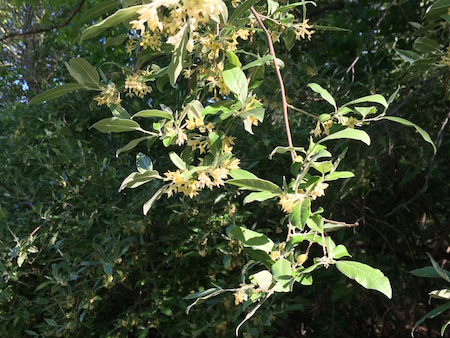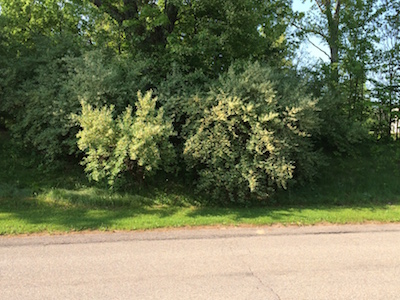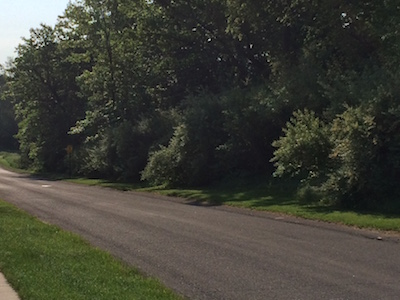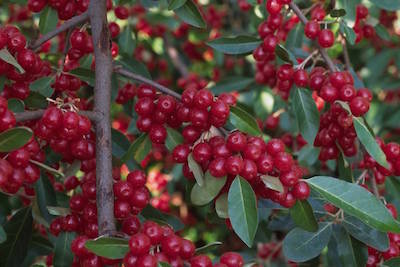Invasive Species Alert: The Autumn Olive Shrub
Elaeagnus Umbellata, commonly known as autumn olive, Japanese silverberry, or spreading oleaster, is an invasive species to North America. Indigenous to eastern Asia, the Autumn Olive is a shrub or small tree spreading rapidly through parts of the U.S.
While you may not be familiar with its name, you’re almost certainly familiar with this invasive plant. It’s quickly taking over natural spaces. Autumn olive is a deciduous shrub (it loses its leaves each fall) that can easily grow to heights of up to 20 feet. It features very fragrant pale yellow flowers that bloom in clusters in the spring from April to June, which turn into pink or red berries. The leaves of the autumn olive shrub are of an elliptical shape with a wavy appearance. The underside of the autumn olive leaf has silvery scales. The autumn olive has been described as having a ‘shimmery’ look to it.
Know Your Enemy: The History of the Autumn Olive in America
Native to Japan, China and Korea, the autumn olive plant was first brought to the U.S. way back in the 1830s. In the mid-20th century, it was promoted as a way to easily control erosion and provide habitat and food for wildlife. It was also recommended as an ornamental shrub and for use as a windbreak. Autumn olive did all of these jobs very well…perhaps too well. The plant quickly began to spread uncontrollably everywhere it was introduced.
Autumn olive thrives in many types of areas, including open fields, woodlands, grasslands. It is extremely drought resistant and can grow in a wide variety of soils. Autumn olive fixes nitrogen in its roots, allowing it to grow vigorously in bare or infertile soils. Autumn olive can be easily found along the eastern seaboard from Virginia to Maine, and throughout the midwest.
The Environmental Trouble with Autumn Olive
If the autumn olive shrub grows easily, controls erosion and provides habitat to wild animals, what’s the problem? Like many invasive species, the autumn olive shrub is causing trouble with native ecosystems.Simply put, autumn olive out-competes and displaces other native plants and trees. Its thick branches and leaves creates dense shade that crowds out other native plants. Autumn olive produces high numbers of seeds per plant, up to 200,000 each year; these hardy seeds can grow almost anywhere due to autumn olive’s nitrogen-fixing roots. The autumn olive is an extremely fast and efficient reproducer.
The large number of seeds produced by the autumn olive extremely attractive to birds, who scatter them everywhere.
For these reasons, the autumn olive is easily one of the most problematic invasive plants.
Dealing with Autumn Olive
Dealing with and removing autumn olive from the ecosystem is much easier said than done. Attempts to remove it by cutting the plants down or burning them only exacerbates the problem. Anyone who has tried to remove autumn olive with these methods is almost always rewarded with even more of the shrubs. Since the autumn olive germinates so easily, cutting or burning simply causes more spreading of the shrub. It’s not unusual to see an empty field completely overrun by autumn olive shrubs within just a year or two.So how do we deal with this invasive shrub? Pulling seedlings early is one effective method. Pulling the plant before it bears fruit will help reduce the spread of seeds. Since most autumn olive shrubs are too big to simply pull up from their roots, more drastic measures are required. Cutting the plant at the trunk will cause the tree to sprout multiple new shoots, so herbicide must be applied to the stump at the time of cutting. Further herbicide applications should be made to ensure the death of the entire root structure.
Possible Benefits of Autumn Olive?
Eradicating the autumn olive completely from an area is very difficult and labor intensive, and as described above, requires the use of herbicides. Until more thorough eradication methods are discovered, the autumn olive is probably here to stay; controlling it in certain areas may be possible, but the optimist in us says we should look for ways to benefit from this invasive plant.
Autumn olive shrubs DO control soil erosion, and they DO provide habitat and food for wildlife. While true, the shrub should not be voluntarily planted in any areas where they don’t already have a foothold.
The berries of the autumn olive shrub (also sometimes known as autumnberlries) are edible to humans. Many wild food foragers have discovered them to be the most commonly available wild fruit in many areas of the country. Single bushes are capable of providing multiple quarts of berries. The berries are believed to contain high levels of lycopene, and are said to be quite tasty.
If you are interested in harvesting wild autumn olive berries, please make sure to do your homework and know the plant. There are many types of wild fruit-bearing trees and shrubs out there, many of which are inedible to humans.
The bottom line here? If you are able to, work to eradicate autumn olive shrubs on your property. Spread the word about this invasive species to other landowners in your area is the best way to bring this plant under control. And DON’T ever plant the shrub! If you do, you may very well be stuck with fields full of them that you’ll never be able to get rid of.
Further Info:
Controlling Autumn Olive and Similar Species: http://mnfi.anr.msu.edu/invasive-species/AutumnOliveBCP.pdfAutumn Olive Berries: http://foragersharvest.com/autumnberry-autumn-olive/
comments powered by Disqus







































































